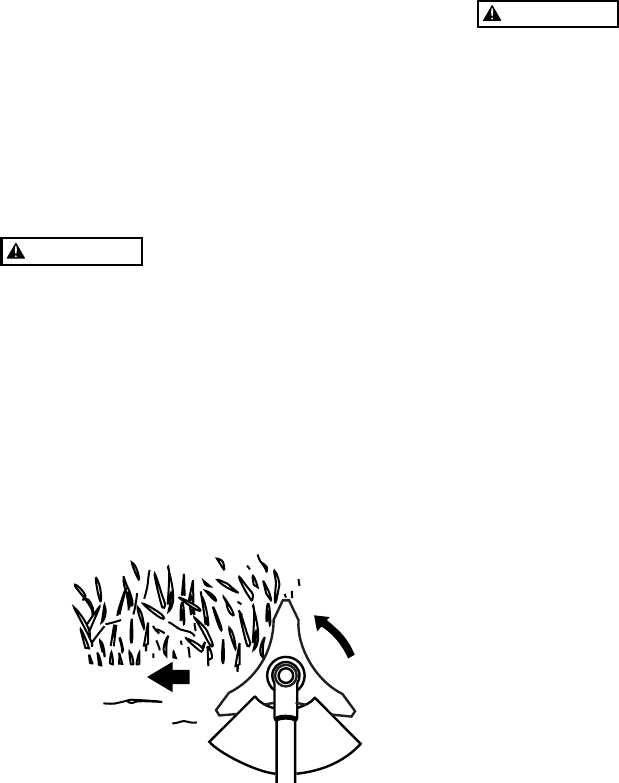
GB-12
WARNING
CONTROLLING BLADE BOUNCE
•Kick out can cause serious personal injury. Carefully
study this section. It is important that you understand
what causes kick out, how you can reduce the chance
of kick out and how you can remain in control of the
unit if kick out does occur.
1. What causes kick out:
• Kick out can occur when the moving blade contacts
an object that it cannot cut. This contact causes the
blade to stop for an instant and then suddenly move
or ”bounce” away from the object that was hit. The
operator can lose control of the unit and the blade
can cause serious personal injury to the operator or
any person nearby if the blade contacts any part of
the body.
2. How you can reduce the chance of kick out:
a. Recognize that kick out can happen. By understand-
ing and knowing about bounce, you can help elimi-
nate the element of surprise.
b. Cut fibrous weeds and grass only. Do not let the blade
contact materials it cannot cut such as hard, woody
vines and brush or rocks, fences, metal, etc
c. Be extra prepared for bounce if you must cut where
you cannot see the blade making contact such as in
areas of dense growth.
d. Keep the blade sharp. A dull blade increase the
chance of bounce.
e. Avoid feeding the blade too rapidly. The blade can
bounce away from material being cut if the blade is
fed faster than its cutting capability.
f. Cut only from your right to your left.
g. Keep your path of advance clear of material that has
been cut and other debris.
3. How you can maintain the best control:
a. Keep a good, firm grip on the unit with both hands. A
firm grip can help neutralize bounce. Keep your right
and left hands completely around the respective
handles.
b. Keep both feet spread apart in a comfortable stance
and yet braced for the possibility that the unit could
bounce. Do not overreach. Keep firm footing and
balance.
8. Operation
CUTTING METHOD
(a)Use the front left side cutting.
(b) Guide the blade from your right to left with it tilted
slightly to your left.
(c) When mowing a wide area, start working from your
left end to avoid interference of cut grass.
(d) The blade may be seized by weeds if the engine
speed is too low, or the blade cuts too deep into
weeds. Adjust the engine speed and cutting depth
according to the condition of object.
WARNING
• If the grass or other object gets caught in the blade,
or if the unit starts to shake or vibrate, turn off the
engine and check the whole unit. Change the blade if
it has been damaged.
•Turn off the engine and make sure the blade has com-
pletely stop before checking the blade, and remov-
ing any object got caught in.


















